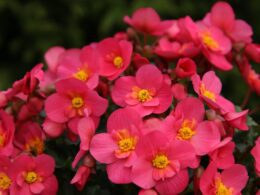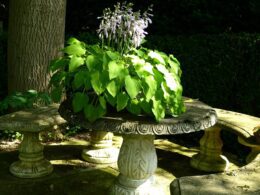Are you looking for plants that will add beauty to your yard all year round? There are many options to choose from, whether you live in a warm or cold climate.
By selecting the right trees, shrubs, grasses, and flowers, you can ensure that your garden looks vibrant and attractive no matter the season.
One of the best ways to ensure constant greenery is to plant evergreen trees and shrubs. These plants retain their foliage throughout the year, providing a consistent backdrop for any other plants you choose to add.
Ornamental grasses are another great option, adding texture and movement to your landscape.
Perennial flowers are also a popular choice, with many varieties blooming at different times of the year to keep your garden colorful and varied.
And for those who want low-maintenance options, succulents are a great choice, providing year-round interest with their unique shapes and colors.
With so many options available, you can create a beautiful and thriving garden that will look great all year round.
Evergreen Trees and Shrubs
You’ll love how these evergreen trees and shrubs keep your garden vibrant and lush in every season. These plants are perfect for those who want a low-maintenance garden that always looks great.
One of the best things about evergreens is that they don’t lose their leaves in the fall, which means you don’t have to worry about cleaning up the yard or raking leaves.
When it comes to evergreens, pruning is key to keeping them healthy and looking their best. The best pruning techniques depend on the type of plant you have, so it’s important to do your research before getting started.
Some common pests and diseases that can affect evergreens include spider mites, scale insects, and blight. However, if you keep your plants healthy with proper watering and fertilization, you can prevent these problems from occurring.
Incorporating evergreen trees and shrubs into your garden is a great way to ensure that your yard looks good all year round. These plants are perfect for adding color and texture to your landscape, and they require very little maintenance.
With the right pruning techniques and care, you can keep your evergreens looking beautiful for years to come.
Ornamental Grasses
The Ornamental Grasses section offers a variety of choices for year-round visual appeal. They’re low maintenance, and they provide many landscaping benefits. Ornamental grasses can add texture, color, and height to your garden. They can also be used to create borders, screens, or as a focal point.
Maintenance tips for ornamental grasses are simple. They require minimal watering and only need to be cut back once a year. However, it’s essential to choose the right type of grass for your climate and soil. Some grasses prefer full sun, while others thrive in partial shade. Be sure to research the type of grass you’re interested in before purchasing.
Incorporating ornamental grasses into your landscaping can provide year-round interest with minimal effort. They add beauty and texture to your garden and attract birds and butterflies. Choose the right type of grass for your climate and soil, and enjoy the low maintenance benefits they offer.
Perennial Flowers
Perennial flowers add a burst of color and fragrance to your garden that can last for years with minimal upkeep. Perennial garden design allows for a variety of blooms throughout the year, ensuring your garden always looks beautiful.
Best perennial flowers for small spaces include:
- Coneflowers: These vibrant flowers come in a range of colors and attract butterflies and birds to your garden.
- Daylilies: These easy-to-grow flowers come in a variety of colors and bloom for several weeks in the summer.
- Black-eyed Susans: These cheerful flowers are drought-resistant and provide a pop of color to any garden.
- Salvia: These long-blooming flowers come in a range of colors and attract hummingbirds to your garden.
Creating a perennial garden design can be as simple as choosing a few of these easy-to-grow flowers and planting them in a small space.
Perennial flowers are an investment in your garden that will continue to bloom year after year, adding beauty and color to your outdoor space. Incorporating the best perennial flowers for small spaces into your garden not only adds aesthetic value, but also provides a sense of security and safety.
Knowing that your garden will look beautiful all year round with minimal upkeep can bring a sense of peace and tranquility to your home. So, whether you have a small space or a large garden, consider perennial flowers in your garden design to add color, fragrance, and a sense of security to your outdoor space.
Succulents
Incorporating succulents into your garden design can bring a unique and sophisticated element to your outdoor space. These versatile plants come in a variety of sizes, shapes, and colors, making them perfect for container gardening. With proper care, succulents can thrive all year round, adding a touch of greenery to your space even in the dead of winter.
Propagation techniques for succulents are relatively easy, making them a great option for those new to gardening. Succulents are able to grow new plants from leaves or cuttings, so you can easily expand your collection without having to purchase new plants. Plus, propagating succulents is a fun and rewarding activity that can be done year-round.
To add a level of sophistication to your outdoor space, consider creating a succulent garden in a decorative container. Below is a table outlining some popular succulent varieties and their unique characteristics:
| Succulent Variety | Characteristics |
|---|---|
| Echeveria | Rosette-shaped leaves in shades of green, pink, and purple |
| Sedum | Low-growing with fleshy leaves in shades of green, yellow, and red |
| Aloe Vera | Thick, spiky leaves with healing properties |
| Crassula | Small, compact plants with round leaves in shades of green and silver |
Incorporating succulents into your garden design not only adds a unique and sophisticated element to your space, but it also allows you to experiment with container gardening and propagation techniques. Whether you’re a seasoned gardener or just starting out, succulents are a great addition to any outdoor space. So why not give them a try and see how they can bring your garden to life all year round?
Year-Round Color
You’ll love the vibrant and colorful atmosphere that can be achieved in your garden during every season with these tips on year-round color.
One way to achieve this is through seasonal plant rotation. This involves switching out plants that are no longer in bloom for ones that are, keeping your garden looking fresh and lively throughout the year. It’s important to research which plants thrive during each season, so you can be sure to have a variety of colors and textures year-round.
Another way to achieve year-round color is by incorporating non-flowering plants. Foliage plants, such as hostas and ferns, offer a range of colors and textures that can add depth and interest to your garden. They also provide a nice contrast to flowering plants, making them stand out even more.
Don’t be afraid to mix and match different types of plants to create a unique and visually appealing garden.
Remember, creating a garden with year-round color takes time and effort, but the results are worth it. By using seasonal plant rotation and incorporating non-flowering plants, you can create a garden that is both beautiful and sustainable.
So, get out there and start planting! Your garden will thank you.
Frequently Asked Questions
How do I care for evergreen trees and shrubs during the winter months?
During the winter months, taking care of your evergreen trees and shrubs is crucial to ensure they survive the frosty weather. Winter evergreen care includes protecting them from harsh conditions and providing adequate water.
To protect your trees and shrubs, you can use frost protection techniques like wrapping them with burlap or covering them with a frost blanket. It’s also important to avoid pruning during the winter, as this can damage new growth.
Additionally, ensure that your evergreens have enough water, as they can still lose water through their leaves during the winter. Following these tips will help you keep your evergreens healthy and strong throughout the winter season.
Can ornamental grasses be used as a privacy screen in my yard?
Looking to add a touch of privacy to your yard? Look no further than ornamental grasses! These versatile plants not only add a unique aesthetic to your landscaping, but they also provide an effective barrier for keeping prying eyes out.
There are many types of ornamental grasses to choose from, such as tall, feathery ones like miscanthus or shorter, clumping varieties like blue fescue. Whichever you choose, be sure to keep them maintained by cutting them back in the spring and fertilizing them periodically.
With a little care, ornamental grasses can be a beautiful and practical addition to any yard.
What are some perennial flowers that are low maintenance and require little watering?
Looking for low maintenance and drought-resistant perennials? Look no further than the best plants for rock gardens. These hardy plants are perfect for those who want to add a touch of color and life to their outdoor space without the hassle of constant watering and maintenance.
Some of the best options include sedum, yarrow, and lavender. Not only are these plants easy to care for, but they also require little water and can withstand harsh weather conditions. Plus, they add a beautiful and natural touch to any rock garden or landscape.
So if you’re looking for an easy way to spruce up your outdoor space, consider adding these low maintenance perennials to your garden.
Can succulents be grown indoors, and if so, what type of lighting do they need?
To keep your indoor succulents thriving, it’s important to provide them with the optimal lighting conditions. While some succulent varieties prefer direct sunlight, others can thrive in low light environments. If you’re looking for the best succulent varieties for low light environments, consider Haworthia, Gasteria, or Sansevieria. These plants can handle less light and don’t require as much watering as other succulents.
When it comes to lighting, a bright, indirect light is ideal for indoor succulents. You can achieve this by placing your plants near a window that receives plenty of natural light, or by using artificial lighting. A full spectrum LED grow light is a great option for indoor succulent care, as it provides the ideal balance of red and blue light for photosynthesis.
Keep in mind that succulents can be sensitive to too much or too little light, so be sure to monitor them closely and adjust their lighting as needed. With the right care, your indoor succulents can thrive and bring a touch of green to your home all year round.
How do I incorporate year-round color into my garden without it looking too busy or overwhelming?
Want to add year-round color to your garden without it looking too busy or overwhelming? Color schemes and plant combinations are key.
Start by choosing a color palette that complements your house and existing landscaping. Then, select plants that bloom at different times throughout the year, so there’s always something in bloom.
To avoid a cluttered look, create focal points with larger plants or garden ornaments. Consider using containers or raised beds to contain your color scheme and add dimension to your garden.
With a little planning and creativity, you can enjoy a vibrant and visually appealing garden all year round.
Conclusion
Well done! You now know what plants look good all year round.
Consider evergreen trees and shrubs for their year-round foliage, low maintenance, and ability to provide privacy.
Ornamental grasses add texture, movement, and color to your garden all year long.
Perennial flowers create a beautiful display of color and can be low maintenance if properly chosen.
Succulents are perfect for those who want a low maintenance garden, as they require little water and can thrive in harsh conditions.
Finally, adding year-round color to your garden can be achieved by using a variety of plants that bloom at different times of the year. Remember to choose plants that are suitable for your climate, soil, and sunlight.
With these tips, your garden will be beautiful and vibrant all year round. Happy planting!








